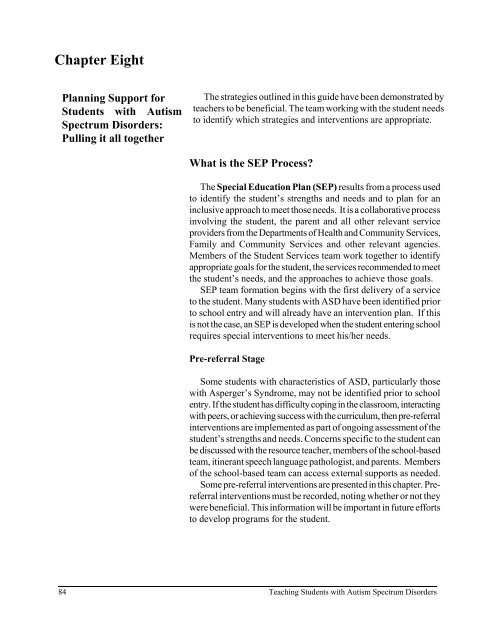Teaching Students with Autism Spectrum Disorders
Teaching Students with Autism Spectrum Disorders
Teaching Students with Autism Spectrum Disorders
Create successful ePaper yourself
Turn your PDF publications into a flip-book with our unique Google optimized e-Paper software.
Chapter Eight<br />
Planning Support for<br />
<strong>Students</strong> <strong>with</strong> <strong>Autism</strong><br />
<strong>Spectrum</strong> <strong>Disorders</strong>:<br />
Pulling it all together<br />
The strategies outlined in this guide have been demonstrated by<br />
teachers to be beneficial. The team working <strong>with</strong> the student needs<br />
to identify which strategies and interventions are appropriate.<br />
What is the SEP Process?<br />
The Special Education Plan (SEP) results from a process used<br />
to identify the student’s strengths and needs and to plan for an<br />
inclusive approach to meet those needs. It is a collaborative process<br />
involving the student, the parent and all other relevant service<br />
providers from the Departments of Health and Community Services,<br />
Family and Community Services and other relevant agencies.<br />
Members of the Student Services team work together to identify<br />
appropriate goals for the student, the services recommended to meet<br />
the student’s needs, and the approaches to achieve those goals.<br />
SEP team formation begins <strong>with</strong> the first delivery of a service<br />
to the student. Many students <strong>with</strong> ASD have been identified prior<br />
to school entry and will already have an intervention plan. If this<br />
is not the case, an SEP is developed when the student entering school<br />
requires special interventions to meet his/her needs.<br />
Pre-referral Stage<br />
Some students <strong>with</strong> characteristics of ASD, particularly those<br />
<strong>with</strong> Asperger’s Syndrome, may not be identified prior to school<br />
entry. If the student has difficulty coping in the classroom, interacting<br />
<strong>with</strong> peers, or achieving success <strong>with</strong> the curriculum, then pre-referral<br />
interventions are implemented as part of ongoing assessment of the<br />
student’s strengths and needs. Concerns specific to the student can<br />
be discussed <strong>with</strong> the resource teacher, members of the school-based<br />
team, itinerant speech language pathologist, and parents. Members<br />
of the school-based team can access external supports as needed.<br />
Some pre-referral interventions are presented in this chapter. Prereferral<br />
interventions must be recorded, noting whether or not they<br />
were beneficial. This information will be important in future efforts<br />
to develop programs for the student.<br />
84 <strong>Teaching</strong> <strong>Students</strong> <strong>with</strong> <strong>Autism</strong> <strong>Spectrum</strong> <strong>Disorders</strong>

















